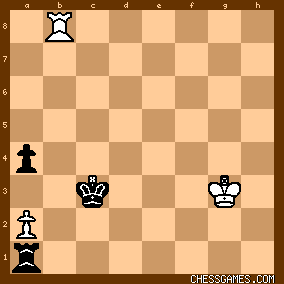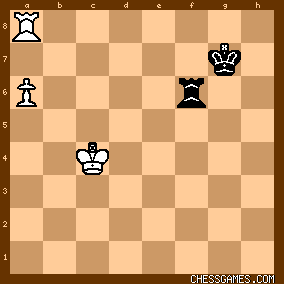| Nov-19-11 | | OneArmedScissor: Wow... Naka almost had him! |
|
| Nov-19-11 | | whiteshark: But near enough is not good enough. :( |
|
| Nov-19-11 | | Eric Farley: Either these two guys don't know the first thing about very basic chess endings(they leave it to Fritz) or Nakamura thinks his opponent is an idiot in this phase of the game. This is the famous Vancura position, a well-known
book draw. It's amazing they kept on playing! |
|
| Nov-19-11 | | Calli: Can't make heads or tails out of it. Why not 36...Rxb2 |
|
| Nov-19-11 | | esticles: <Eric> Neither, Naka just prefers to play his games to the bitter end. It's more for the spectators then the opponent -- chess would be less fun to watch if the players always agreed to a draw as soon as they knew what was coming. |
|
| Nov-19-11 | | wordfunph: "Very tough game with many opportunities, but things just did not break my way...quite a pity." - GM Hikaru Nakamura
http://www.chess.co.uk/twic/chessne... |
|
| Nov-20-11 | | Appaz: <<Eric Farley> Either these two guys don't know the first thing about very basic chess endings(they leave it to Fritz) or Nakamura thinks his opponent is an idiot in this phase of the game.> It's probably just you who have more knowledge about the customs in international tournaments than these "super" GMs. |
|
Nov-20-11
 | | HeMateMe: People make mistakes. Make'em play it out. |
|
| Nov-20-11 | | Eric Farley: To add: This is the Vancura position. This position, the Lucena position, and the Philidor position make up the three pillars of Rook Endings. In Korchnoi's book "Practical Rook Endings" they are in the first chapter titled "The ABC of Rook Endings." In Emms' book "The Survival Guide to Rook Endings" they're also in the first chapter "Basic Rook Endings." I don't want to sound nostalgic because I'm too young for that, but I think the days of Capablanca and Rubinstein are over. |
|
| Nov-20-11 | | bronkenstein: <...I think the days of Capablanca and Rubinstein are over.> Indeed , just the players are not to blame (they both seemed to know about the Vancura, judging by the press conf.) IIRC 10th Lasker-Schlechter Match game was played for 3 days , including lunch breaks and stuff. Blame the tempo! PS what should be the age limit for nostalgy? =) |
|
| Nov-20-11 | | nimh: If you want to compare something on absolute level, you naturally have to use equivalent comparison bases. Claiming that Capablanca, Rubinstein or Lasker were better endgame players than super GM-s of today, using selected notable examples from textbooks in the case of older masters, and live broadcast engine analyses with today's GM-s doen't make any sense. |
|
Nov-25-11
 | | Penguincw: According to the Endgame Explorer here are the stats for ♔♖ vs. ♔♖♙ The superior side (black) wins 46.2% of the time.
A draw occurs 53.6% of the time.
The inferior side (white) wins a mere 0.2% of the time. Some the game will likely be a draw. But in this game, that doesn't seem to matter since it's going to be drawn by the 3 fold repetition rule. |
|
Nov-27-11
 | | Peligroso Patzer: <Eric Farley: Either these two guys don't know the first thing about very basic chess endings (they leave it to Fritz) or Nakamura thinks his opponent is an idiot in this phase of the game. This is the famous Vancura position, a well-known book draw. It's amazing they kept on playing!> Well, it seems to me it is always reasonable to make the opponent demonstrate he knows theory before agreeing to the theoretical result, and this seems especially true with respect to the Vanèura Defense, which is much more technically difficult than the Lucena or Philidor methods. As GM John Nunn has observed, “[i]t is surprising how often strong players misplay this type of position [referring specifically to the Vanèura Position].” Nunn, John, Understanding Chess Endgames, Gambit Publications Ltd. ©2009, at page 120, section 51b. As one example of the mishandling of a Vanèura Position, look at Euwe vs Alekhine, 1935, as analyzed in Dvoretsky, Mark, Tragicomedy in the Endgame: Instructive Mistakes of the Masters, Russell Enterprises, Inc., ©2011, at pages 27-28. After <55. … Rc1-a1>, the position was: 
click for larger view Euwe erred immediately with <56. Kf3?> (instead of continuing correctly with <56. Rf8! Rxa2 57. Rf4> (or <57. Rf3>). After the further <56. … Rxa2 57. Ke3>, however, Alekhine then erred with <57. … Rh2?> (instead of taking advantage of White’s misplaced pieces by playing <57. … a3!>). After Alekhine’s mistake, although the position is no longer a Vanèura Position, Euwe could have obtained a theoretically drawn position by playing <58. Ra8!>. Dvoretsky gives these variations (after <57. … Rh2? 58. Ra8!>) [A] <58. … Kb3 59. Kd3! a3 60. Rb8+ Ka2 61. Kc3> or [B] <58. … Rh4 59. Rc8+ Kb3 60. Rb8+> (“also possible is 60. Kd3 or 60. Kd2” – MD), “and on <60. … Rb4> White exchanges rooks” – MD. Euwe, however, erred with <58. Rc8+?>, and Alekhine did not let him off the hook again. Euwe resigned on move 66. Although Euwe may have been the “weakest world champion” (as many believe), he was a very strong player. Furthermore, the study by Josef Vanèura (1898-1921) published posthumously in 1924 (just eleven years before the game discussed above was played) caused a sensation when it demonstrated Black’s drawing method after White tried <1. Kb5> from this position: 
click for larger view ...
which had long been believed to be winning. Euwe certainly must have heard of Vanèura’s study, and yet he misplayed the defense. In short, apart from positions that have reduced to a Lucena or a Philidor, rook endgames are tricky and are often worth playing out. I am a little surprised Nakamura did not play a little further, for example, making Nepomniachtchi prove he knows what to do if the black king goes over to c4 to challenge the plan of lateral checks from the b-file. |
|
| Nov-27-11 | | bronkenstein: TY for nice chess history lesson <Peligroso> . PS pity this kind of post normally produces zero feedback , as opposed to plain trolling or flaming . But don`t worry , there is many silent readers outthere =) |
|
| Nov-27-11 | | King Death: <peligroso patzer> It's very surprising that after an adjournment, both champions would misplay this position. This ending is an example of what the modern player needs to understand or know going into a game, since there aren't adjournments any more. |
|
Nov-28-11
 | | Check It Out: I second bronkenstein's post - good stuff, Peligroso Patzer. |
|
Sep-24-13
 | | offramp: This game took place over four days. |
|
Sep-24-13
 | | perfidious: <offramp>: Not quite so long as the Battle of Kursk, but long enough, I should think. As <Peligroso> states, despite his errors in the above fragment, Euwe could play a little. |
|
Sep-25-13
 | | offramp: <offramp: This game took place over four days...> ...ago. I was interrupted LOL! |
|
| Sep-25-13 | | Abdel Irada: <offramp: <offramp: This game took place over four days...> ...ago.> Just a bit.
<I was interrupted LOL!> Good thing you had time to click the "Kibitz" button, and then to click again on the preview page. ;-) ∞ |
|





